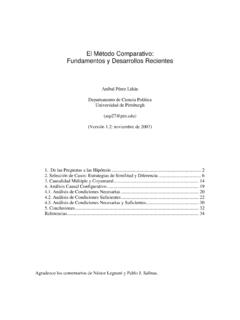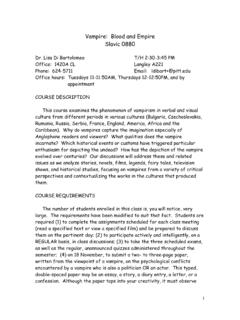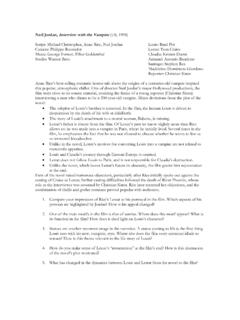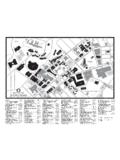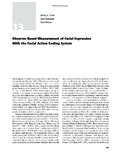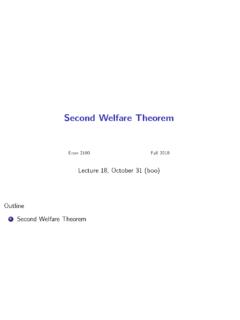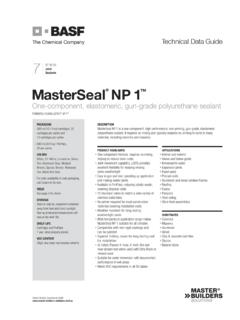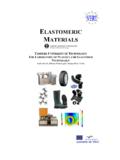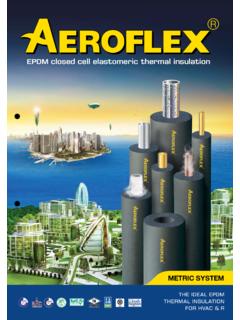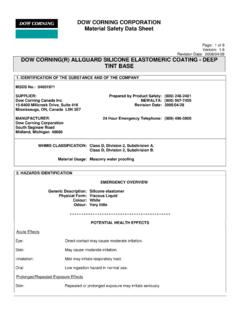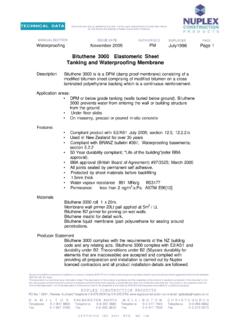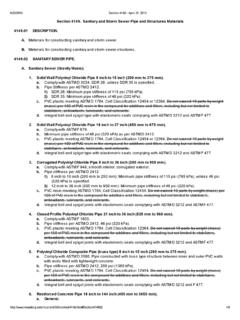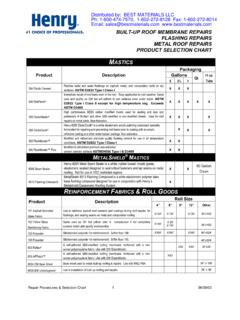Transcription of High-field deformation of elastomeric dielectrics …
1 Materials Science and Engineering C 11 2000 89 deformation of elastomeric dielectrics for actuatorsRon Pelrine), Roy Kornbluh, Jose Joseph, Richard Heydt, Qibing Pei, Seiki ChibaSRI International, 333 Ra enswood A enue, Menlo Park, CA 94025, USAA ccepted 3 November 1999 AbstractThis paper investigates the use of elastomeric dielectric materials with compliant electrodes as a means of actuation. When a voltage isapplied to the electrodes, the elastomeric films expand in area and compresses in thickness. The strain response to applied electric fieldswas measured for a variety of elastomers. A nonlinear, high-strain, Mooney Rivlin model was used to determine the expected strainresponse for a given applied field pressure. Comparing this analytical result to with experimentally measured strains, we determined thatthe electrostatic forces between the free charges on the electrodes are responsible for the observed response.
2 Silicone polymers haveproduced the best combination of high strain and energy density, with thickness strains up to 41% and elastic energy densities up to Response times of 2 ms have been experimentally measured. This paper also reports recent progress in making highly compliantelectrodes. We have shown, for example, that gold traces fabricated in a zig-zag pattern on silicone retain their conductivity whenstretched up to 80%, compared to 1 5% when fabricated as a uniform two-dimensional electrodelayer. Optimal loading of dielectricelastomers can have a significant impact on performance: and the paper describes techniques which that can increase output up to a factorof 5 compared to neutral loading conditions. Lastly, the paper briefly discusses the performance of various actuators that use dielectricelastomer materials. The technology appears to be well-suited to a variety of small-scale actuator Published byElsevier Science :Electroactive polymers; Artificial muscle; Electrostrictive polymers; Polymer actuators1.
3 IntroductionIn many small-scale systems, such as micro robots andother portable or mobile microdevices, the need for im-proved actuators is particularly critical because conven-tional electromagnetic actuators generally have poor effi-ciency at small scales. There has been much recent interestin electroactive polymers as actuator materials. In general,polymers are attractive as actuator materials because theyare lightweight, easily fabricated in various shapes, andlow cost. Within the general category of polymers, themany different possible approaches to actuators includewxwxelectrostrictive polymers 1 5 , piezoelectric polymers 6 ,wxshape memory polymers 7 , electrochemically actuatedwxconducting polymers 8 13 , polymer-based air-gap elec-wxtrostatic devices 14 , and so and actuator materials have several importantperformance parameters including energy density, specificenergy density, strain, actuation pressure, response time,)Corresponding author.
4 E-mail R. Pelrine .and efficiency. To this list must be added practical consid-erations such as environmental tolerance, fabrication com-plexity, and reliability. Given this range of performancemeasures, it is not surprising that different applicationsdepend more heavily on only one or a few performanceparameters. Nonetheless, we consider a useful, generalpurpose actuator technology to be one with good overallperformance, as opposed to excellent performance in oneor two parameters and poor performance in others. Thisview is supported by the dominance of electromagnetictechnology on macro scales where electromagnetic actua-tors have good overall performance, as well as by the goodoverall performance of natural muscle in nature over awide range of size paper describes an approach to electroactive poly-mer actuators that uses the deformation of dielectric elas-tomers.
5 The actuator performance of these materials issimilar in many respects to the performance of naturalmuscle. For this reason, dielectric elastomer actuators canbe regarded as a type ofartificial muscle. The principle ofoperation is shown in Fig. 1. An elastomeric polymer issandwiched between two compliant electrodes. When a0928-4931r00r$ - see front matterq2000 Published by Elsevier Science .PII: S 0 9 2 8 - 4 9 3 1 0 0 0 0 1 2 8 - 4()R. Pelrine et Science and Engineering C 11 2000 89 10090 Fig. 1. Principle of operation of dielectric difference is placed across the top and bottomelectrodes, the polymer is squeezed in thickness andstretched in area by the electric field derivation of the electrostatic model of actuation iswxdescribed by Pelrine et al., 15 . The effective actuationpressure,p, is given by22ps Es Vrz,1.
6 OowhereEis the electric field , is the dielectric constant, is the permittivity of free space,Vis the voltage, andz0is the polymer thickness. Note that this pressure is greater,by a factor of 2, than that arising from the commonly usedequation for Maxwell s stress in a dielectric of a rigid platecapacitor. The greater pressure is due to the compliance ofthe electrodes, which allows both the forces of attractionbetween the oppositely charged electrodes and the forcestending to separate the charges on each electrode to coupleinto the effective pressure normal to the plane of the small strains with free boundary conditions, thepolymer thickness strain,s, is given byz2ssyprYsy VrzrY,2 ..zowhereYis the modulus of elasticity. The model for largestrains with more realistic constrained boundary condi-tions, such as those required to drive a load, is morecomplex.
7 However, this simple case illustrates the influ-ence of the electrical and mechanical properties of thepolymer on actuation performance. The model also as-sumes that the elastomer is an ideal rubber, that is, that therubber is incompressible and has a Poisson s ratio of of the more useful metrics for comparing actuatormaterials, independent of size, is the energy density of thematerial. Theactuator energy densityis the maximummechanical energy output per cycle and per unit volume ofmaterial. The actuator energy density depends on the load-ing conditions as described in Section 7. For small strainswith free boundary conditions, the actuator energy density,e, of the material can be written asa242espssYss ..azzoConventionally, theelastic energy density es1r2Ys2ezis often used. However, for large strains with a linearstress strain relation this formula must be modified be-cause as the thickness strain becomes increasingly nega-tive, the film flattens out and the area over which thepressure must be applied increases.
8 A more detailedderivation for large strains gives the formula for the elasticenergy density of materials with a linear stress strainrelation ..ezzThis equation agrees with the more common formula atsmall strains but is significantly higher for strains greaterthan 20%.2. Experimental procedure for measuring material per-formanceThe experiments in our study were designed to measurethe response of different polymer materials to appliedelectric fields. The purpose of the experiments was toidentify the most promising polymers, compare the poly-mer actuator s performance to that of other actuator tech-nologies, and determine the validity of our electrostaticmodel of measurement of the performance of different poly-mer materials is complicated by the fact that several of thepolymer materials evaluated are relatively soft, with elasticmoduli below 1 MPa.
9 Therefore, the constraints on thepolymer film must be carefully controlled. The situation isfurther complicated by the fact that film samples are often()R. Pelrine et Science and Engineering C 11 2000 89 10091 .Fig. 2. Experimental setup top view .quite thin. We therefore used optical methods to measurethe strain condition of the polymer measurement configuration is shown in Fig. 2. Athin film of a polymer is stretched uniformly across acircular hole in a rigid frame. Electrodes are applied to arelatively small circular area at the center of this a voltage is applied to the electrodes, the filmbetween the electrodes expands in area and contracts inthickness. This expansion in area is measured with anoptical microscope, a video camera, video digitizing hard-ware, and digital measurement software.
10 The softwaremeasures the amount of motion of identifiable features on .the surface of the electrodes such as texture featureswhen a voltage is applied. By comparing the location ofthe features at a given voltage to the locations at zerovoltage, we determine the in-plane strain at a given volt-age. The magnification of the microscope and resolution ofthe video camera are such that a single pixel representsonly a small portion of the observed motion. Most mea-sured motions were on the order of tens of pixels. Pho-tographs of one such experiment with Dow Corning HS31silicone are shown in Fig. effects of creep and mechanical hysteresis on themeasured strain were minimized by obtaining the strainreading immediately following the application of the volt-age. The voltage was brought to zero between each mea-surement.


